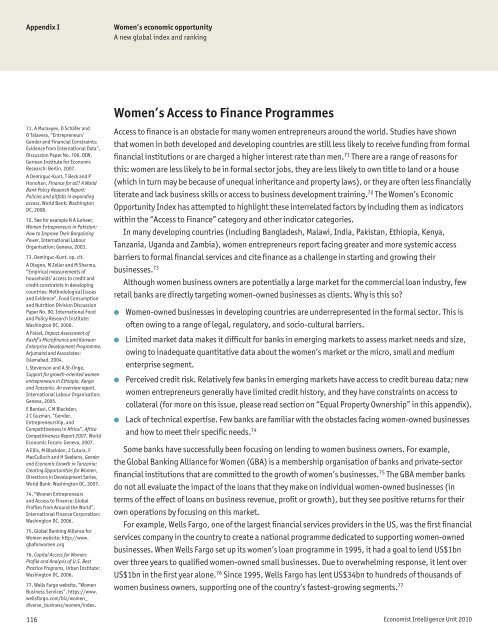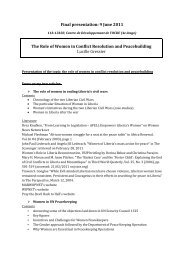Women's Economic Opportunity Index - Economist Intelligence Unit
Women's Economic Opportunity Index - Economist Intelligence Unit
Women's Economic Opportunity Index - Economist Intelligence Unit
- No tags were found...
Create successful ePaper yourself
Turn your PDF publications into a flip-book with our unique Google optimized e-Paper software.
Appendix IWomen’s economic opportunityA new global index and rankingWomen’s Access to Finance Programmes71. A Muravyev, D Schäfer andO Talavera, “Entrepreneurs’Gender and Financial Constraints:Evidence from International Data”,Discussion Paper No. 706, DIW,German Institute for <strong>Economic</strong>Research: Berlin, 2007.A Demirguc-Kunt, T Beck and PHonohan, Finance for all? A WorldBank Policy Research Report:Policies and pitfalls in expandingaccess, World Bank: WashingtonDC, 2008.72. See for example N A Goheer,Women Entrepreneurs in Pakistan:How to Improve Their BargainingPower, International LabourOrganisation: Geneva, 2003.73. Demirguc-Kunt, op. cit.A Diagne, M Zeller and M Sharma,“Empirical measurements ofhouseholds’ access to credit andcredit constraints in developingcountries: Methodological Issuesand Evidence”, Food Consumptionand Nutrition Division DiscussionPaper No. 90, International Foodand Policy Research Institute:Washington DC, 2000.A Faisel, Impact Assessment ofKashf’s Microfinance and KarvaanEnterprise Development Programme,Arjumand and Associates:Islamabad, 2004.L Stevenson and A St-Onge,Support for growth-oriented womenentrepreneurs in Ethiopia, Kenyaand Tanzania. An overview report.International Labour Organisation:Geneva, 2005.E Bardasi, C M Blackden,J C Guzman, “Gender,Entrepreneurship, andCompetitiveness in Africa”, AfricaCompetitiveness Report 2007, World<strong>Economic</strong> Forum: Geneva, 2007.A Ellis, M Blackden, J Cutura, FMacCulloch and H Seebens, Genderand <strong>Economic</strong> Growth in Tanzania:Creating Opportunities for Women,Directions in Development Series,World Bank: Washington DC, 2007.74. “Women Entrepreneursand Access to Finance: GlobalProfiles from Around the World”,International Finance Corporation:Washington DC, 2006.75. Global Banking Alliance forWomen website: http://www.gbaforwomen.org76. Capital Access for Women:Profile and Analysis of U.S. BestPractice Programs, Urban Institute:Washington DC, 2006.77. Wells Fargo website, “WomenBusiness Services”. https://www.wellsfargo.com/biz/women_diverse_business/women/index.Access to finance is an obstacle for many women entrepreneurs around the world. Studies have shownthat women in both developed and developing countries are still less likely to receive funding from formalfinancial institutions or are charged a higher interest rate than men. 71 There are a range of reasons forthis: women are less likely to be in formal sector jobs, they are less likely to own title to land or a house(which in turn may be because of unequal inheritance and property laws), or they are often less financiallyliterate and lack business skills or access to business development training. 72 The Women’s <strong>Economic</strong><strong>Opportunity</strong> <strong>Index</strong> has attempted to highlight these interrelated factors by including them as indicatorswithin the “Access to Finance” category and other indicator categories.In many developing countries (including Bangladesh, Malawi, India, Pakistan, Ethiopia, Kenya,Tanzania, Uganda and Zambia), women entrepreneurs report facing greater and more systemic accessbarriers to formal financial services and cite finance as a challenge in starting and growing theirbusinesses. 73Although women business owners are potentially a large market for the commercial loan industry, fewretail banks are directly targeting women-owned businesses as clients. Why is this so?● Women-owned businesses in developing countries are underrepresented in the formal sector. This isoften owing to a range of legal, regulatory, and socio-cultural barriers.● Limited market data makes it difficult for banks in emerging markets to assess market needs and size,owing to inadequate quantitative data about the women’s market or the micro, small and mediumenterprise segment.● Perceived credit risk. Relatively few banks in emerging markets have access to credit bureau data; newwomen entrepreneurs generally have limited credit history, and they have constraints on access tocollateral (for more on this issue, please read section on “Equal Property Ownership” in this appendix).● Lack of technical expertise. Few banks are familiar with the obstacles facing women-owned businessesand how to meet their specific needs. 74Some banks have successfully been focusing on lending to women business owners. For example,the Global Banking Alliance for Women (GBA) is a membership organisation of banks and private-sectorfinancial institutions that are committed to the growth of women’s businesses. 75 The GBA member banksdo not all evaluate the impact of the loans that they make on individual women-owned businesses (interms of the effect of loans on business revenue, profit or growth), but they see positive returns for theirown operations by focusing on this market.For example, Wells Fargo, one of the largest financial services providers in the US, was the first financialservices company in the country to create a national programme dedicated to supporting women-ownedbusinesses. When Wells Fargo set up its women’s loan programme in 1995, it had a goal to lend US$1bnover three years to qualified women-owned small businesses. Due to overwhelming response, it lent overUS$1bn in the first year alone. 76 Since 1995, Wells Fargo has lent US$34bn to hundreds of thousands ofwomen business owners, supporting one of the country’s fastest-growing segments. 77116 <strong>Economist</strong> <strong>Intelligence</strong> <strong>Unit</strong> 2010




